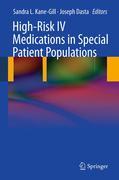
High-risk IV medications in special patient populations
Kane-Gill, Sandra
Dasta, Joseph
Critical Care Clinicians can use general drug references (Micomedex, Lexicomp) for data on dosing of high-alert medications in special patient populations but these references are not available to all healthcare clinicians, they are expensive and they are not specific to high-alert medications or critically ill patients. Doctors, nurses and pharmacists in the hospital setting will benefit from having one resource with all of this information. The purpose of this reference manual would be to guide critical care clinicians on dosing of high-alert medications in special patient populations. The most important feature of the book will be a summary of primary literature using tables when possible.This will be useful to readers because currently a reference book does not exist that guides clinicians in these difficult dosing decisions. The Institute for Safe Medication Practices has developed a list of high-alert medications which are medications at a heightened risk for patient harm when used in error. No book has been published on this topic. A resource containing all relevant information at a glance would be time-saving. This resource will provide information to those who do not typically have access (community settings). INDICE: Anesthetic agents (general, inhaled, intravenous). Propofol, ketamine, etc. Anti-infectives. aminoglycosides, vancomycin, drotrecogin, amphotericin products. inhaled agents. Anticoagulants agents. unfractionated heparin, low molecular weight heparins, fondaparinux, lepirudin, argatroban, bivalrudin,abciximab, eptifibatide, tirofiban. Thrombolytics –reteplase, tenecteplase, streptokinase, urokinase, alteplase. Cardiac Drugs. Adrenergic agents. dopamine, dobutamine, vasopressin, , nitroglycerin, nitroprusside epinephrine, norepinepherine, phenylepherine. Adrenergic antagonists. Propranolol, diltiazem, verapamil, esmolol, labetalol, clevidipine. Antidyrrhthmics. amiodarone, lidocaine, procainamide. Inotropic agents. milrinone, amrinone, isoproterenol, niseritide, digoxin. Prostanoids. Epoprostenol, iloprost, treprostenil. Electrolytes. Potassium, magnesium, sodium chloride (hypertonic), cardioplegic solutions. Hypoglycemics. Insulin and oral agents. Neuromuscular blocking agents. vecuronium, rocuronium, cisatracurium, atracurium, succinylcholine. Opioids (IV, oral).Remifentanyl, fentanyl , morphine, hydromorphone, meperidine. Sedatives (IV, oral and transdermal). lorazepam, midazolam, diazepam, propofol, dexmedetomidine. Information for Each Drug. Propofol. Normal. Obese. Renal Dysfunction. CrCL. Dialysis (HD, CRRT). Liver Dysfunction. Recommendations for Safe Use.
- ISBN: 978-0-85729-605-4
- Editorial: Springer London
- Encuadernacion: Cartoné
- Páginas: 160
- Fecha Publicación: 01/07/2011
- Nº Volúmenes: 1
- Idioma: Inglés
